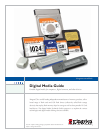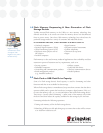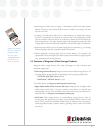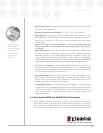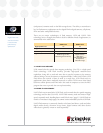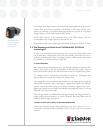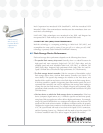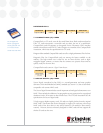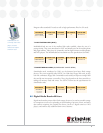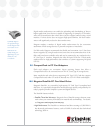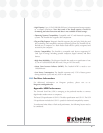
COMMITTED TO MEMORY
For example, most digital cameras use NAND-Flash based digital film, as pictures are
usually taken and stored sequentially. NAND-Flash is also more efficient when
pictures are read back, as it transfers whole pages of data very quickly. As a sequential
storage medium, NAND Flash is ideal for data storage.
NAND Flash memory is less expensive than NOR Flash memory, and can
accommodate more storage capacity in the same die size.
Flash memory which stores a single bit per cell is known as Single-Level Cell (SLC) Flash.
Die-Stacking and Multi-Level Cell/Multi-Bit Cell Flash
technologies
In order to economically increase the amount of bit-storage that a flash memory chip
can accommodate, manufacturers often utilize die-stacking and multi-level cell or
multi-bit cell technologies. These technologies result in a flash memory chip having
the capability to store more data in a single chip.
5.1 DIE-STACKING
Many semiconductor manufacturers use a “die-stacking” technique to double a flash
memory chip’s capacity. After the semiconductor wafer fabrication process, they cut
out the flash memory silicon “die” and then attach or stack two separate dies together.
For example, when a semiconductor manufacturer stacks two 128-megabit dies
together, they form a single 256-megabit flash memory chip.
Die-stacking allows for cost-reduced chip alternatives to the larger-capacity, single-die
chips (called “monolithic” chips). Stacking two 1-gigabit chips together, for example,
typically costs far less than buying a low-volume monolithic 2-gigabit chip. The 2-
gigabit chip can then be used to build a 256 MB flash card (single chip card), or a 512 MB
flash card (two chips on one card).
Die-stacking is similar to the DRAM chip-stacking technology that Kingston utilizes to
produce high-end server modules. As a result, Kingston’s die-stacked flash cards are
reliable and deliver high performance.
5.2 MULTI-LEVEL CELL (MLC) FLASH TECHNOLOGIES
NAND and NOR Flash memory chips typically store one (1) bit value (a ‘0’ or a ‘1’)
in each cell. In multi-level flash technologies, three (3) or more values are stored into
each cell.
FLASH MEMORY KINGSTON TECHNOLOGY 7
kingston.com/flash
CompactFlash cards
were the first small
form factor flash
memory cards.
5.0



